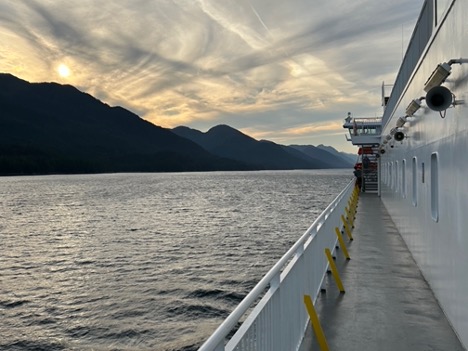A Ferry Tale
Contact
University of Arkansas System Division of Agriculture
Cooperative Extension Service
2301 S. University Ave.
Little Rock, AR 72204

A Ferry Tale
If you aren’t striving to rack up new experiences while traveling, you are doing it wrong. Heading into the Pacific Northwest, it is easy for a farm boy to pack in multiple new experiences each day as I travel north through the maritime region of British Columbia. The ferry systems that operate here, for example, are a marvel to me.
I’ve traveled ferries before, even in Arkansas. The ferry across Lake Norfolk in Baxter County was always a delight, but it — and the other two river ferries I rode more than 40 years ago — are now replaced with bridges. What the modern bridges provide in efficiency, they surely sacrifice in charm.
My first destination on the way to Alaska, after picking up a friend in Seattle, was Port Angeles, Washington. I had mapped out the general route in advance, unfortunately including a three-hour slog down I-5 at rush hour. But plugging the destination into my GPS, I was surprised to be routed away from the interstate to a small ferry. Both routes took about the same amount of time, but the ferry ride was a giant sigh of relief when compared to the bumper-to-bumper traffic of a big city freeway.
To the unaccustomed traveler, ferries are a bit of a mystery mixed with the fear of literally missing your boat if you don’t get there on time. So, when I’m told to show up two hours before sailing, believe me, I’m there sitting in line. Like any experienced traveler, the locals are a bit more casual about the whole thing and know all the tricks to ensure they get a spot on board.
We made the hour-long crossing between Port Angeles and Victoria, British Columbia without mishap, but entry into Canada was a bit more interesting. Of the 100 or so cars and RVs on the ferry, mine was the only one singled out for a search. Maybe because they couldn’t believe anyone from Arkansas didn’t have a gun squirreled away someplace or, maybe I have a tell: When I told the border guard I had no alcohol on board (I actually had two six-packs of beer), we were pulled out of line to be gone through. We never could get them to tell us why we got the honor, but that was one of those new experiences that make travel so interesting.
Vancouver Island, at 250 miles long, is the largest island in North America. It has a classic maritime climate; cool, wet summers and mild, wet winters. Lush and green is the order of the day, so not surprisingly one of the world’s premier display gardens is located just north of Victoria, the capital city of British Columbia. Butchart Gardens began as a pleasure garden in about 1910 in a limestone quarry by the wife of the quarry owner who made a fortune turning limestone into cement.
This was my third visit to this magical place. The garden has natural features; big evergreen trees, enormous piles of rocks and curving paths, but the bedding plant display is pure shock and awe. Colorful plantings of annuals in the brightest colors are used in enormous beds. Borders are peppered with mixtures of annual flowers in eye-catching combinations that leave you wondering why you never thought of that. And, because of the bright sunshine and cool nights, the pigment saturation of the flowers is the best that it can possibly be. And the level of plant maintenance is so phenomenal you suspect flowers are deadheaded when they begin to think about withering.
Listening to the chatter of other visitors — and there are plenty of them — you feel like a visitor in a far-off foreign land. English is seldom heard. I’m embarrassed that I speak no other language, and that my knowledge of foreign languages is so poor I can’t even guess the homelands of fellow visitors. I experienced this while visiting several sites in the desert southwest. Most of the visitors were foreign. I had a Navajo guide tell me that on his trips, usually half were from Europe, a quarter from Asia, and the rest from the United States or Latin America. Maybe we Americans have already been there and done that, or maybe it is that seeing things close to home just isn’t cool.
After a few delightful days exploring Vancouver Island, we boarded another ferry and headed up the inner coastal waterway to Prince Rupert, B.C. This 18-hour long ride took us about 400 miles north and loaded my bucket with many new experiences. Many of the passengers on the ferry were walk-on passengers who used the ship as a convenient way to get from town to their homes in the north woods. With time to kill, these friendly folk are usually more than willing to share with the green traveler some of the local lore.
